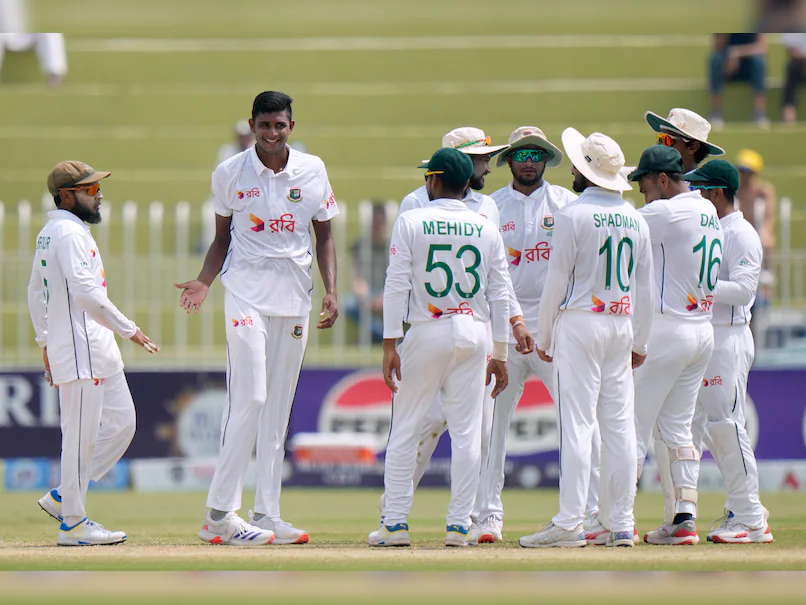Shafique Falls Early as Taskin Strikes – Weather Drama Unfolds!
Cricket fans were eagerly awaiting the much-anticipated clash between Pakistan and Bangladesh in the second Test match in Rawalpindi. But what they got was a rollercoaster of emotions as the match, set to be a thrilling contest, was heavily influenced by the unpredictable weather. Rain, strategic decisions, and early setbacks combined to make Day 2 a gripping spectacle. Here’s a complete breakdown of the action so far.
Day 1: Rain Washes Out Play, Leaving Fans Disappointed
The first day of the second Test was a complete washout. Rawalpindi, known for its unpredictable weather, lived up to its reputation. Overnight rain drenched the outfield, leaving puddles all over the pitch, making it unplayable. Despite several inspections by the umpires, the persistent rain ensured that no play was possible. By the end of the day, with skies still grey, the entire day’s play was called off, leaving players and fans frustrated.
Bangladesh Leads the Series: A High-Stakes Game
This second Test carries significant weight. Bangladesh entered the match with a 1-0 lead in the two-match series after their historic win in the first Test, also played in Rawalpindi. That victory sent shockwaves through the cricketing world, particularly in Pakistan, where the loss was seen as a major upset. With crucial World Test Championship (WTC) points at stake, Pakistan knew they had to bounce back strongly to stay in the race.
Day 2 Begins: Bangladesh Elects to Field Amid Damp Conditions
When the rain finally relented on the morning of Day 2, Bangladesh captain Najmul Hossain Shanto won the toss and made a strategic decision to field first. With the pitch still damp from the rain, the conditions were expected to favor the bowlers, especially during the early overs. Shanto’s decision was a clear indication that Bangladesh aimed to exploit the conditions to their advantage, putting Pakistan’s batting lineup under immediate pressure.
Pakistan’s Early Woes: Abdullah Shafique Dismissed for a Duck
The match kicked off with Pakistan’s opening pair walking out to bat, but their innings got off to a disastrous start. Taskin, Bangladesh’s pace spearhead, wasted no time in making an impact. In just the second over of the innings, Taskin delivered a beautiful outswinger that caught Abdullah Shafique off guard. The young opener edged the ball straight to the slips, and Pakistan found themselves one wicket down with barely any runs on the board.
This early dismissal was a huge blow for Pakistan. Shafique, who has shown promise in recent matches, was expected to provide a solid start for his team. His wicket left Pakistan reeling, and the pressure now shifted to the more experienced batsmen in the lineup.
The Role of Weather: A Constant Threat to Play
Rawalpindi’s weather remained a significant factor throughout the day. Although the rain had stopped, the overcast conditions and the damp outfield meant that the pitch was far from ideal for batting. The moisture in the pitch made the ball move unpredictably, giving the bowlers an edge. Both teams knew that the weather could turn at any moment, adding an extra layer of tension to the proceedings.
Bangladesh’s Bowling Strategy: Taskin Leads the Charge
Taskin was the star of the morning session. His ability to generate pace and movement in these conditions made him a formidable opponent for the Pakistani batsmen. With the new ball in hand, Taskin bowled a tight line and length, forcing the batsmen to play defensively. His early dismissal of Shafique set the tone for Bangladesh’s bowling attack, and they continued to apply pressure throughout the session.
Taskin’s performance was backed up by the other bowlers, who maintained the pressure on Pakistan. The fielding was sharp, and Bangladesh’s bowlers looked hungry for more wickets. Every run was hard-earned, and Pakistan found themselves in a battle to survive the early overs.

Pakistan’s Playing XI: A Team Under Pressure
Pakistan’s playing XI for this match featured a mix of experience and youth, but the team was under significant pressure after their loss in the first Test. Here’s a look at the lineup:
- Abdullah Shafique
- Saim Ayub
- Shan Masood (c)
- Babar Azam
- Saud Shakeel
- Mohammad Rizwan (w)
- Agha Salman
- Khurram Shahzad
- Abrar Ahmed
- Mohammad Ali
- Mir Hamza
With Shafique’s early dismissal, the onus was now on the likes of Shan Masood, Babar Azam, and Mohammad Rizwan to steer Pakistan out of trouble. The team’s captain, Shan Masood, in particular, needed to lead from the front and build a solid partnership with the middle order.
Bangladesh’s Momentum: Taskin Ahmed’s Fiery Spell
Taskin Ahmed’s early breakthrough wasn’t just a wicket; it was a psychological blow to Pakistan. It disrupted their game plan and forced them to rethink their approach. Taskin continued to bowl with pace and precision, keeping the batsmen on their toes. His ability to swing the ball both ways made him a constant threat, and Bangladesh’s fielders supported him brilliantly, ensuring that no easy runs were conceded.
Bangladesh’s bowlers were clearly feeding off the energy provided by Taskin’s early success. The pressure they applied was relentless, and Pakistan’s batsmen found it difficult to break free. Every dot ball added to their frustration, and Bangladesh’s confidence grew with each passing over.
World Test Championship Implications: A Crucial Contest
This match holds more than just series pride for both teams. The World Test Championship (WTC) points on offer are crucial, particularly for Pakistan, who are currently lagging behind in the standings. Bangladesh, sitting at 7th on the WTC table, is just ahead of Pakistan, who are in 8th place. A win in this match would not only secure the series for Bangladesh but also significantly boost their WTC campaign.
For Pakistan, the stakes couldn’t be higher. A loss in this match would not only result in a series defeat at home but also severely dent their chances of making it to the top of the WTC standings. The pressure to perform is immense, and every run, wicket, and session of play could have a major impact on the outcome of the match.
Pakistan’s Middle Order: A Test of Resilience
As the day progressed, Pakistan’s middle order came under the spotlight. With the early loss of Shafique, the experienced heads in the lineup had to step up. Captain Shan Masood and Babar Azam, Pakistan’s batting mainstays, were tasked with steadying the ship. They needed to build a partnership, absorb the pressure, and guide their team to a respectable total.
Babar Azam, in particular, was key to Pakistan’s hopes. Known for his elegant stroke play and ability to anchor the innings, Babar had to find a way to counter Bangladesh’s disciplined bowling attack. Alongside him, Mohammad Rizwan, one of the most reliable players in the team, needed to bring his A-game to the crease.
Bangladesh’s Fielding: Sharp and Disciplined
Bangladesh’s fielding was a standout feature of the day’s play. The team was alert, and every opportunity to apply pressure was seize. Whether it was a diving stop in the infield or a sharp catch in the slips, Bangladesh’s fielders were on point. This high level of intensity in the field added to Pakistan’s struggles, as they found it difficult to score freely.
Taskin Ahmed’s efforts were complement by his teammates, who ensured that every ball counted. The fielding placements were smart, and Bangladesh’s captain, Najmul Hossain Shanto, made sure to keep the pressure on Pakistan by constantly rotating his bowlers and keeping the fielders in key positions.
The Rawalpindi Pitch: A Bowlers’ Paradise
The pitch at Rawalpindi, with its damp conditions, turned out to be a paradise for bowlers. The moisture in the surface made the ball move unpredictably, and the overcast skies meant that swing bowlers like Ahmed could extract maximum benefit. The pitch offered variable bounce, and the ball often skidded off the surface, making life difficult for the batsmen.
As the day wore on, the pitch began to dry out slightly, but it still remained challenging for the batsmen. Both teams knew that the first innings would be crucial, as batting in the fourth innings on this pitch could be an even tougher task.
Bangladesh’s Confidence: Eyeing a Historic Series Win
Bangladesh’s confidence was evident throughout the day.
After their historic win in the first Test, they came into this match with a belief that they could win the series.
The early wicket of Shafique only served to boost their morale, and they played with an aggressive mindset.
Bangladesh’s bowlers were not just looking to contain; they were hunting for wickets.
This positive approach was a reflection of the team’s growth in Test cricket. Under the leadership of Najmul Hossain Shanto, Bangladesh had shown that they could compete with the best,
and now they were on the verge of achieving a rare series win on Pakistani soil.
Read More: WWW The Evolution of : A Digital Revolution Unveiled
Conclusion: Pakistan vs Bangladesh 2nd Test – A Match Balanced on a Knife-Edge
As Day 2 of the second Test in Rawalpindi came to a close, the match was finely poised.
Bangladesh’s early success with the ball put them in a strong position, but Pakistan’s experienced middle order was still in the fight. The weather remained a looming factor,
and both teams knew that the match could swing either way with just one good session.
For Pakistan, the challenge was to rebuild after the early setback and post a competitive total that would give their bowlers something to defend.
For Bangladesh, the aim was to continue their disciplined bowling and keep Pakistan on the back foot. With so much at stake in the World Test Championship, the next few sessions would be crucial in determining the outcome of this enthralling contest.
Cricket fans around the world will be eagerly watching to see how this drama unfolds.
Will Bangladesh secure a historic series win,
or will Pakistan stage a comeback to level the series? The answers lie in the days to come, as this fascinating Test match continues to captivate the cricketing world.







